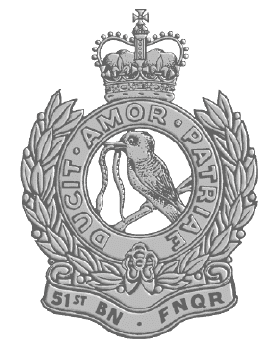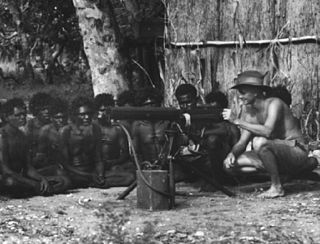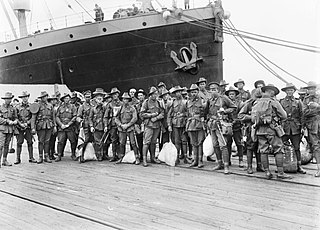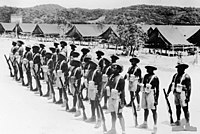
The 51st Battalion, Far North Queensland Regiment is an Australian Army Reserve Regional Force Surveillance Unit headquartered at Porton Barracks in Cairns. The battalion's primary role is to conduct reconnaissance and surveillance tasks in support of border security operations. Its area of operations includes the Torres Strait and the Cape York littoral environment. Additional tasks for 51FNQR include the collection and collation of military geographic information as well as community engagement and disaster relief operations.
The Regional Force Surveillance Units (RFSUs) are specialised infantry units of the Australian Army Reserve responsible for patrolling northern Australia. Collectively, the RFSUs form the Regional Force Surveillance Group commanded by a Colonel based at the 2nd Division Headquarters in Sydney. The RFSUs conduct regular operational patrols during peacetime, and are composed primarily of Reservists who live within the area of operations. There are currently three battalion-sized RFSUs:

Reginald Walter Saunders, MBE was the first Aboriginal Australian to be commissioned as an officer in the Australian Army. He came from a military family, his forebears having served in the Boer War and the First World War. Enlisting as a soldier in 1940, he saw action during the Second World War in North Africa, Greece and Crete, before being commissioned as a lieutenant and serving as a platoon commander in New Guinea during 1944–1945. His younger brother Harry also joined the Army, and was killed in 1942 during the Kokoda Track campaign.

Coconut Island, Poruma Island, or Puruma in the local language, is an island in the Great North East Channel near Cumberland Passage, Torres Strait, Queensland, Australia. One of the Torres Strait Islands, Coconut Island is 130 kilometres (81 mi) northeast of Thursday Island. Administratively, Coconut Island is a town and Poruma Island is the locality within the Shire of Torres.

Yam Island, called Yama or Iama in the Kulkalgau Ya language or Turtle-backed Island in English, is an island of the Bourke Isles group of the Torres Strait Islands, located in the Tancred Passage of the Torres Strait in Queensland, Australia. The island is situated approximately 100 kilometres (62 mi) northeast of Thursday Island and measures about 2 square kilometres (0.77 sq mi). The island is an official locality known as Iama Island within the local government area of Torres Strait Island Region. The town, also called Yam Island, is located on the north-west coast of the island. In the 2021 census, Iama Island had a population of 275 people.

Stephens Island, called Ugar in the local Meriam language, lies in the eastern group of the Torres Strait Islands archipelago of Queensland, Australia. The island is within the locality of Ugar Island within the local government area of the Torres Strait Island Region.

A pioneer is a soldier employed to perform engineering and construction tasks. The term is in principle similar to sapper or combat engineer.

Merauke Force was an Australian-led military force of World War II which was responsible for defending Merauke in Dutch New Guinea from Japanese attack amidst the Pacific War. The force was established in late 1942 and was disbanded at the end of the war, having never seen combat. The Japanese attack did not eventuate and from mid-1944 the force was progressively drawn down and its assigned units redeployed to Australia or elsewhere in the Pacific. At its height, Merauke Force included troops from Australia, the Netherlands East Indies and the United States, as well as several squadrons of aircraft, including a joint Australian-Dutch fighter unit.

The 11th Brigade is an Australian Army brigade which currently comprises most Australian Army Reserve units located in Queensland. The brigade was first formed in early 1912 following the introduction of the compulsory training scheme. Later, as part of the 3rd Division and saw action during World War I on the Western Front as part of the First Australian Imperial Force. In the interwar years, the brigade was re-raised with its headquarters in Brisbane.

The 26th Battalion was an infantry battalion of the Australian Army. Originally raised in April 1915 for service in World War I as part of the Australian Imperial Force (AIF), it was assigned to the 7th Brigade and consisted of personnel recruited from the states of Queensland and Tasmania. The battalion fought at Gallipoli in the latter stages of that campaign before being withdrawn to Egypt in late 1915. In mid-1916, it was sent to Europe where it served in the trenches of the Western Front in France and Belgium for the rest of the war, fighting in most of the battles that the Australians took part in between 1916 and 1918. At the end of the war, it was disbanded in May 1919 as part of the demobilisation of the AIF.

The 31st Battalion, Royal Queensland Regiment was a Reserve infantry battalion of the Australian Army. Although it was officially formed as 31 RQR in 1965 the battalion can trace its lineage back to units formed in 1881 as part of the colonial defence forces of the state of Queensland.

The 31st/51st Battalion was an infantry battalion of the Australian Army, which served during World War II. Raised for service as part of the Militia in 1943 through the amalgamation of two previously existing battalions, the 31st/51st Battalion undertook garrison duties in Dutch New Guinea in 1943–44 before taking part in the Bougainville Campaign in 1944–45. Following the end of the war, the battalion served in the Pacific overseeing the transfer of Japanese prisoners of war and re-establishing law and order until mid-1946 when it returned to Australia and was disbanded.

The Battle of Porton Plantation took place near the village of Soraken on Bougainville Island, in the Solomon Islands archipelago during World War II. Involving forces from Australia, New Zealand and Japan, the battle was part of the wider Bougainville campaign, which had begun in late 1943 and lasted until the end of the war in August 1945. The battle formed part of Australian efforts to liberate the northern part of Bougainville.

The 29th/46th Battalion was an infantry battalion of the Australian Army. It was formed in August 1942 by the amalgamation of two previously existing Militia battalions, the 29th and 46th, which were merged following a decision by the Australian government to release manpower from the military back into industry to meet the nation's increased production requirements. Initially the 29th/46th, serving as part of the 4th Brigade, undertook garrison duties in Australia, however, in 1943 the battalion was deployed to New Guinea where it garrisoned Milne Bay before subsequently taking part in the Huon Peninsula campaign in support of the 9th Division. In late 1944, after being deployed for over a year and a half, the battalion returned to Australia for a brief period of leave and reorganisation. In early 1945, however, they were again deployed overseas, this time to the island of New Britain where they undertook a campaign to contain the large Japanese garrison. Following the end of the war the battalion was disbanded in June 1946.
The 2/3rd Pioneer Battalion was a pioneer battalion of the Australian Army, which served during World War II. Formed in 1940, the battalion served in the Middle East where it fought in Syria and Palestine before taking part in the fighting around El Alamein. In 1943, the battalion returned to Australia and subsequently took part in the fighting against the Japanese in New Guinea in 1943–1944. Their final campaign came in mid-1945, when they took part in the Battle of Tarakan during the Borneo campaign. The battalion was disbanded in early 1946.

The Northern Territory Special Reconnaissance Unit (NTSRU) was an irregular warfare unit of the Australian Army during World War II, composed mainly of Aboriginal people from the Northern Territory. Formed in 1941, the unit patrolled the coast of Arnhem Land during 1942–43 searching for signs of Japanese landings and trained to fight as guerrillas using traditional weapons in the event of an invasion. In 1943, as the war moved northward from the Australian coast, the NTSRU was disbanded.

The 5th Machine Gun Battalion was an infantry support unit of the Australian Army. Originally formed in March 1918 for service during World War I as part of the all volunteer Australian Imperial Force, it was one of five such units raised as part of the AIF during the war. The battalion consisted of four machine gun companies, which had previously existed as independent companies assigned mainly at brigade level. The battalion took part in the final stages of the war, seeing action during the Allied defensive operations during the German spring offensive and then the Allied Hundred Days Offensive, which finally brought an end to the war. The battalion was disbanded in mid-1919 during the demobilisation of the AIF following the conclusion of hostilities. During World War II, the battalion was re-raised as part of the Militia in September 1942, and undertook garrison duties in the Torres Strait, until it was disbanded in May 1944.
The Snake Bay Patrol was an auxiliary reconnaissance unit made up of Indigenous Australian residents of Melville Island in the Northern Territory that was raised by the Royal Australian Navy during World War II. After the first bombing raid on Darwin in 1942, special units consisting of Indigenous Australians were formed, one of which was the Snake Bay Patrol. The Snake Bay Patrol unit was established by Royal Australian Naval Volunteer Reserve officer Lieutenant J.W.B. Gribble during the Pacific War to detect any Japanese forces which landed on the island, with local Indigenous Australians being informally recruited and never formally enlisted into the military. The Patrol's 35 members served on a full-time basis, received firearms training, were issued naval uniforms and held naval ranks conferred by Gribble, but were not paid. Similar units were raised on Bathurst Island, the Cox Peninsula and Groote Eylandt.

Dauan Island is an island in the Torres Strait, Queensland, Australia; it is also known as Cornwallis Island. Dauan Island is also a town and locality in the Torres Strait Island Region, Queensland, Australia.

Masig Island is an island and locality in the Torres Strait Island Region, Queensland, Australia. In the 2021 census, Masig Island had a population of 283 people.


















